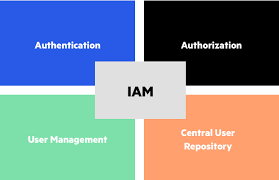The Importance of Identity Access Management Services
Identity Access Management (IAM) services play a crucial role in today’s digital landscape, where data security and privacy are paramount. IAM services encompass processes, technologies, and policies that manage digital identities and control access to resources within an organisation. Let’s delve into why IAM services are essential for businesses of all sizes.
Enhanced Security
One of the primary benefits of IAM services is enhanced security. By implementing robust authentication and authorisation mechanisms, IAM helps prevent unauthorised access to sensitive information. With features such as multi-factor authentication and role-based access control, businesses can ensure that only authorised individuals have access to specific resources.
Improved Compliance
Compliance with regulations such as GDPR, HIPAA, and PCI DSS is a significant concern for organisations across industries. IAM services aid in achieving compliance by maintaining detailed logs of user activities, enforcing access policies, and facilitating audits. This not only helps in meeting regulatory requirements but also enhances data governance practices.
Increased Productivity
Effective IAM services streamline the user provisioning and deprovisioning processes, making it easier for IT teams to manage user accounts efficiently. Automation features reduce manual intervention, saving time and resources. This results in increased productivity across the organisation as employees can access the resources they need promptly without unnecessary delays.
Cost Savings
By centralising identity management functions and automating routine tasks, IAM services help reduce operational costs associated with managing user identities. The elimination of manual processes lowers the risk of errors and enhances overall operational efficiency. Additionally, IAM solutions often offer scalability options that grow with the business without significant additional investments.
Conclusion
In conclusion, Identity Access Management services are indispensable for modern businesses looking to secure their digital assets effectively. From bolstering security measures to ensuring regulatory compliance and improving operational efficiency, IAM services offer a comprehensive solution to identity management challenges. By investing in robust IAM solutions, organisations can safeguard their data assets while enabling seamless access for authorised users.
Enhancing Security: Six Essential Tips for Effective Identity Access Management
- Implement strong password policies to enhance security.
- Use multi-factor authentication for an added layer of protection.
- Regularly review and update user access permissions to prevent unauthorized access.
- Monitor user activity and set up alerts for suspicious behaviour.
- Ensure employees receive proper training on identity access management best practices.
- Consider using a centralised identity management system for easier administration.
Implement strong password policies to enhance security.
Implementing strong password policies is a fundamental aspect of enhancing security within Identity Access Management services. By requiring users to create complex passwords that include a combination of letters, numbers, and special characters, organisations can significantly reduce the risk of unauthorised access to sensitive information. Strong passwords act as the first line of defence against cyber threats and malicious actors, ensuring that only authenticated users can access critical resources. Regularly updating passwords and enforcing password expiry policies further strengthens security measures and helps mitigate the risk of data breaches.
Use multi-factor authentication for an added layer of protection.
Implementing multi-factor authentication (MFA) is a highly recommended practice when it comes to identity access management services. By requiring users to provide multiple forms of verification before accessing sensitive resources, such as a password along with a unique code sent to their mobile device, MFA significantly enhances security. This additional layer of protection helps mitigate the risk of unauthorised access, even if login credentials are compromised. Utilising MFA ensures that only authorised individuals with the necessary permissions can securely access critical data and systems within an organisation.
Regularly review and update user access permissions to prevent unauthorized access.
Regularly reviewing and updating user access permissions is a fundamental tip in Identity Access Management services to mitigate the risk of unauthorised access. By conducting periodic audits of user permissions, organisations can ensure that individuals only have access to the resources necessary for their roles. This proactive approach not only enhances security but also helps in maintaining compliance with data protection regulations. By staying vigilant and promptly revoking unnecessary access rights, businesses can significantly reduce the likelihood of security breaches and protect their sensitive information effectively.
Monitor user activity and set up alerts for suspicious behaviour.
To enhance the security of your digital environment, it is crucial to monitor user activity and establish alerts for any suspicious behaviour when utilising Identity Access Management services. By actively tracking user actions and setting up alerts for anomalies or potential threats, organisations can proactively detect and respond to security incidents. Monitoring user activity allows for the identification of unusual patterns or unauthorised access attempts, enabling swift action to mitigate risks and protect sensitive data. This proactive approach helps bolster overall cybersecurity defences and ensures that any potential breaches are promptly addressed.
Ensure employees receive proper training on identity access management best practices.
To maximise the effectiveness of identity access management services, it is crucial to ensure that employees receive proper training on best practices. By educating staff on the importance of maintaining secure passwords, recognising phishing attempts, and following access control policies, organisations can significantly reduce the risk of data breaches and unauthorised access. Training empowers employees to play an active role in safeguarding sensitive information and reinforces a culture of security awareness throughout the organisation.
Consider using a centralised identity management system for easier administration.
When implementing Identity Access Management services, it is advisable to consider utilising a centralised identity management system for simplified administration. By centralising user identities and access controls in one system, businesses can streamline user provisioning, authentication, and authorisation processes. This approach not only enhances security by providing a single point of control but also facilitates easier management of user accounts across various applications and systems. With a centralised identity management system in place, organisations can efficiently manage access rights, track user activities, and ensure compliance with regulatory requirements.

